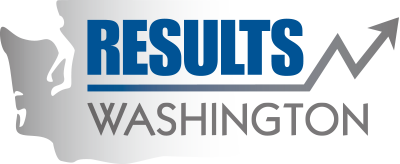Archived: National Highway System pavement, state- and locally-owned, in poor condition
The percent ofall Washington state National Highway System (NHS) roads (state and localcombined) in poor condition is shown in the top graph. Pavement in poorcondition for roads owned by state or local agencies is shown separately in thesecond graph. The Washington State Department of Transportation (WSDOT) managesstate-owned roads and is responsible for their maintenance and preservation,whereas local agencies (cities and counties) are responsible for maintaining andpreserving the pavement on local-owned roads. State-owned roads account for 77%(11,451 lane miles) of the NHS, local-owned NHS roads account for 23% (3,336lane miles). The current replacement value for the state-owned pavement is$13.0 billion; local-owned pavement is $2.6 billion (estimated dollar figuresexclude consideration of roadway shoulders, ramps or other special-use lanes).
Washington statecitizens and visitors rely on the state’s road system to safely and effectivelymove people and goods. NHS pavements are of particular importance because theyare part of a network of strategic highways within the United States servingmajor airports, ports, defense facilities, rail and/or truck terminals andother transport facilities. Preserving and maintaining NHS roads in fair orbetter condition is important to the region's economic vitality.
For the NHSstate-owned roads, WSDOT uses Practical Solutions as a performance-basedapproach that focuses on identifying specific pavement needs and applyingsolutions at the least cost. As part of Practical Solutions, WSDOT seeks toefficiently manage assets such as pavement, at the lowest life cycle cost.Pavement kept in fair or better condition lasts longer, ensuring a return ontransportation investments that serve the public for the least cost totaxpayers. Pavement that is in poor condition causes increased fuel use andvehicle wear and tear. Drivers pay $446 per year in extra vehicle repair andoperating costs due to driving on Washington roads in need of repair, accordingto the April 2018 TRIP report.
Controlling thepercent of NHS pavement condition in poor condition, as well as good condition,is part of the federal performance management efforts under the federal actknown as Moving Ahead for Progress in the 21st Century (MAP-21). MAP-21specifies that interstate pavement condition cannot exceed more than 5% lanemiles in poor condition. Per the federal performance rule, each state must alsoestablish performance targets for poor and good pavement conditions for theremaining NHS pavement on state- and locally-owned roadways.
The majority ofstate and local agency pavements have generally remained in good conditionwithin Washington state. Regardless, the percentage of NHS pavement in poorcondition remained steady from 2015 through 2016 at 7%. Applying PracticalSolutions–along with appropriate funding–is critical to a successful pavementprogram and maintaining pavement in a state of good repair.
The percentageof state-managed NHS pavement in poor condition worsened from 5.4% in 2015 to6.6% in 2016. For locally-managed NHS pavements, 13.1% were in poor conditionin 2015 with conditions improving to 11.4% in 2016.
WSDOT practicescontinuous improvement in deploying strategies that maximize service life andlower life cycle costs.
- Implement practical solutions -WSDOT uses the practical design approach to make project decisions that focuson the specific problem that the project is intended to address. Thisperformance-based approach looks for lower cost solutions in order to meetspecific performance criteria. Converting asphalt surfaces to chip seal (gravelchips bonded to the roadway surface) is an example of these strategies. Theestimated cost savings typically range from $10,000 to $15,000 annually perlane mile.
- Strategic pavement maintenance -Performing maintenance treatments at the appropriate time (before moreexpensive rehabilitation is needed) extends pavement life and results in lowerannual cost. In August 2014, WSDOT implemented a policy that no pavementrehabilitation should take place without first using strategic maintenance toextend pavement life. To date, WSDOT is saving about $6.7 million each year byextending asphalt pavement life by up to four years with this approach.
- Prioritize cost effective concretepavement projects- WSDOT has drafted 10- and 30-year strategic plans toevaluate and prioritize minor-to-moderate pavement rehabilitation (triage)efforts, along with the more major pavement reconstruction efforts across thestate’s concrete pavement network. Concrete pavement accounts for 50% ofWashington’s interstate system and is aging beyond original 20-year lifeprojections with half of state-owned concrete pavement over 40 years old. WSDOTexpects costs to be approximately $95 million annually over the 30-year periodfor rehabilitation or reconstruction of 1,350 miles of concrete pavement.
- Incentivizing local agency assetmanagement practices for NHS facilities – WSDOT is developing a program withthe objective to highlight the importance of preserving the roadway system, andto promote the use of a pavement management system to provide cost-effectivesolutions that will maximize the life expectancy of a roadway. To meet thisobjective the program will evaluate a local agency’s use of a pavementmanagement system, along with the level of funding the agency provides tomaintain their roadway system, and emphasize pavement rehabilitation overreconstruction to focus on cost-effectiveness. Approximately $75 million willbe distributed through two calls for projects by May 2019. The first call forprojects will distribute $30-$40 million, and limits applications to the 103local agencies with pavement on the NHS.
For additional information about the condition of the state’s pavement and the actions WSDOT is taking to maintain and preserve pavement today and for the future, see Gray Notebook 68, pp. 16-26, at http://wsdot.wa.gov/publications/fulltext/graynotebook/gray-notebook-Dec17.pdf#page=16
Learn more about WSDOT pavement performance at
http://www.wsdot.wa.gov/Business/MaterialsLab/Pavements/PavementNotebook.htm
Learn more about the National Highway System at
http://www.wsdot.wa.gov/mapsdata/travel/hpms/NHSRoutes.htm
Learn more about WSDOT's strategic plan and agency emphasis areas at:
http://www.wsdot.wa.gov/publications/fulltext/secretary/WSDOTStrategicPlan.pdf?v=2
Contact the following boards and organizations for ways to get more involved:
Transportation Improvement Board (TIB)
County Road Administration Board (CRAB)
Washington State Association of Counties (WSAC)
